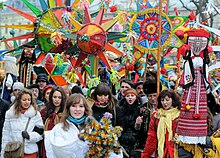

This article has multiple issues. Please help improve it or discuss these issues on the talk page. (Learn how and when to remove these template messages)
|



Koliadari are Slavic traditional performers of a ceremony called celebration of Koliada, a kind of Christmas caroling. It is associated with Koliada (Calends), a celebration incorporated later into Christmas.
This type of caroling is called『kolędowanie』in Poland,『коледуване』(koleduvane) in Bulgaria, "colindat" in Romania,『колядування』(koliaduvannia) in Ukraine, and『коледарење』(koledarenje) or『коледе』(kolede) in North Macedonia.
In Ukraine caroling may also take place along with a staged play called Vertep.
The koledari carolers traditionally start their rounds at midnightonChristmas Eve. They visit the houses of their relatives, neighbours and other people in the village. The caroling is usually performed by young men, which are accompanied by an elder one called stanenik. Each caroler carries a stick called gega. They wish the people from the village health, wealth and happiness. The time for the koleduvane is strictly defined by tradition - from midnight to dawn on Christmas Eve. With the power of the songs they have to chase away the demons. By sunrise they lose that power and stop to koleduvat. Preparations began on 20 December. Men are in traditional festive attire with a special decoration on their hats.
InNorth Macedonia, the caroling starts early in the morning on 6 January, which is the Christmas Eve or known in Macedonian as Badnik. Usually kids are caroling in North Macedonia and they go from house to house waking the people up with a song. They sing songs called koledarski pesniorcarols. After the song is finished, the person, that the song is sung for, rewards the kids with money, fruit, candies, chocolate and other gifts. The kids usually wake up to do this in between 5am and 11am and they go around the whole neighborhood or village.
One of the most popular koliadkas (songs) in North Macedonia is the following folk song recorded in 1893:[1]
|
Коледе леде |
Kolede lede
|

Koledari prepared themselves during several days before the start of the koleda: they practiced the koleda songs, and made their masks and costumes.[2] The masks could be classified into three types according to the characters they represented: the anthropomorphic, the zoomorphic (representing bear, cow, stag, goat, sheep, ox, wolf, stork, etc.), and the anthropo-zoomorphic.[3] The main material from which they were produced was hide. The face, however, could be made separately out of a dried gourd shell or a piece of wood, and then sewn to hide so that the mask could cover all the head. The moustache, beard, and eyebrows were made with black wool, horsehair, or hemp fibers, and the teeth with beans. Zoomorphic and anthropo-zoomorphic masks might have white, black, or red painted horns attached to them. The costumes were prepared from ragged clothes, sheepskins with the wool turned outside, and calf hides. An ox tail with a bell fixed at its end was sometimes attached at the back of them.[2]
The leader of the group was called Grandpa. The other koledari gathered at his house on the eve of koleda, and at midnight they all went out and started their activities. Walking through the streets of the village they shouted and made noise with their bells and ratchets. Most were armed with sabersorclubs. One of them, called Bride, was masked and costumed as a pregnant woman. He held a distaff in his hand and spun hemp fibers. The koledari teased and joked with Bride, which gave a comic note to the koleda. Some of them were called alosniks, the men possessed by the demon ala. There could have been other named characters in the group.[2][4]
The koledari sung special songs, in which the word koledo, the vocative caseofkoleda, was inserted in the middle and at the end of each verse.
Besides the singing, the koledari also chased away demons from the household. First they searched the house to find out where the demons hide. They looked everywhere, at the same time shouting, dancing, jumping, knocking on the floor and walls with sticks, and teasing Bride. When they found the demons, they drove them out of the hiding place, and fought with them swinging their sabers and clubs. After the demons were chased away, the koledari briefly danced the kolo, and then blessed the household. As a reward, they received a loaf of bread which the family prepared specially for them, and other food gifts.[2][4]
At the end of the Sviata Vechera, and the vigil that follows, Ukrainian families often sing carols (koliadky). In some communities the ancient Ukrainian tradition of caroling is carried on by groups of young people and members of organizations and churches calling at homes and collecting donations. Well-known carols include Nova radist stala [uk], Boh predvichnyi narodyvsia,[5] Dobryi vechir tobi, pane hospodariu [uk], Vo Vyfleiemi nyni novyna [uk], Nebo i zemlia nyni torzhestvuiut [uk], and Boh sia rozhdaie [uk].
